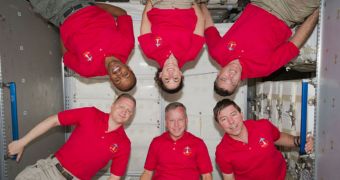The space shuttle Discovery is about to say farewell to the International Space Station and outer space for ever. The spacecraft will separate from the orbital facility today, March 7, and head for a March 9 landing at the Kennedy Space Center (KSC), in Florida.
The 12 astronauts onboard the space lab got together on Sunday, March 6, and participated in the official farewell ceremony, which took place in the American-built Destiny module.
All participants were assembled by 3:30 pm EST (2030 GMT), and then all of them said their goodbyes. “It was a pleasure to be up here,” said shuttle commander Steve Lindsey.
“We appreciate your hospitality. On behalf of the crew, we had a great time. We're going to miss you guys,” the NASA astronaut added. He was the leader of the STS-133 mission to the ISS.
“It was very successful time onboard with you guys. We really enjoyed having guests – this is the first group of guests I've had in 150 days since I've been here. We're going to miss you,” replied ISS Commander and NASA astronaut Scott Kelly.
He also went on to praise the retiring shuttle, and highlighted its many achievements. Discovery is the oldest and most used of the three orbiters the American space agency currently operates. It will be retired once it lands at the KSC.
“Discovery has been a great ship, and has really supported the [ISS], more so than any other space shuttle, and we wish her fair winds and following seas,” Kelly said. “We're going to miss Discovery.”
After the ceremony concluded, the astronauts said one final goodbye, and then the six members of the STS-133 crew passed through the hatch attaching Discovery to the ISS.
The door was sealed at 4:11 pm EST (2111 GMT), and the shuttle astronauts slept overnight in the vehicle. They are aiming to land on Wednesday at 11:58 am EST (1658 GMT), two days after leaving the ISS.
Later today, they are scheduled to conduct the second heat shield verification test of the flight. The first one was carried out before they reached the station, and the upcoming one is meant to determine whether the shuttle sustained any damage during its stay in orbit.
Oftentimes, micrometeorites slam into the sensitive tiles of the heat shields, and cause dents. It's damage such as this that caused the Columbia orbiter to go up in flames in 2003, as it was reentering Earth's atmosphere.
The two mandatory heat shield scans that NASA introduced afterwards are meant to ensure that something like this does not happen again, Space reports.

 14 DAY TRIAL //
14 DAY TRIAL //